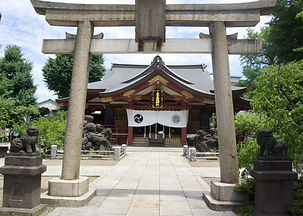普通の外にいくつかの著名な品質を持っている、と畏敬の念を起こさせるあるいかなるビーイングは、カミと呼ばれています。
Nearest station
Minamisenju
Hibiya Line
Tōkyō-to, Arakawa-ku, Minami Senju 6-60-1
東京都荒川区南千住6-60-1
Home page: (Japanese)
July 18, 2017
素盞雄神社
Susano-o Jinja
History
The shrine was founded by the leading disciple of En no Gyōja, a man called Kokuchin (黒珍). He lived near a mound surmounted by a strangely shaped rock which he considered sacred and worshipped. One night in 795, April 8 to be precise, he was preparing to purify himself when a light suddenly appeared from a fissure in the rock and took the shape of two old men: they told him they were Gozu-Tennō (牛頭天王, an alternative name for Susano-o Ōkami) and Asuka Kongen (飛鳥権現) and that if they were worshipped epidemics could be prevented, happiness increase, and the locality would flourish. Kokuchin immediately built a hokora on the site, and separate halls enshrining the two kami soon followed. In 1718 the two shrines were destroyed by fire and nine years later both deities were enshrined in a single new hall, the Zuikō-den (瑞光殿, lit. "Auspicious Light Hall.") Zuikō-seki is the name given to the rock from which the two kami materialized, and in early Meiji times, 1864, a Fujizuka was built around it. A few years before this, in 1858, a cholera epidemic had struck Edo and the number of people visiting the shrine rose sharply. The introduction of the Shin-butsu Bunri policy in 1868 saw the name of Gozu-Tennō and Asuka Kongen officially changed to Susano-o Ōkami and Asuka Ōkami, while the official name of
Enshrined Deities:
Main
Susano-o-no mikoto (57) 須佐之男命
Kotoshiro-nushi (90) 事代主命
From Merged Shrines
In-ground Shrines:
Kumano Jinja 熊野神社
Hiei Jinja 日枝神社、
Wakamiya Hachiman Gū 若宮八幡宮
Sengen Jinja 浅間社
Fukutoko-Inari Jinja 福徳稲荷神社
Sugahara Jinja 菅原神社
Inari Jinja 稲荷神社
Earliest mention of: 795
Annual Festivals: June 3, Sept. 15


the shrine became Susano-o Jinja. After the 1945 fire-bombing raids had reduced the shrine to ashes the prayer hall was rebuilt in 1957, the main hall in 1981.
Description
In pre-modern times, when child survival rates were very low, there was a proverb 七歳までは神の子, loosely translated it says that until we are seven we are children of god. The underlying idea was that a child who passed away before the age of seven had not so much died as had its spirit torn away by a vengeful ghost 物の怪 (mononoke): once it reached the age of seven it would be entitled to a proper funeral ceremony. The ema shown above, which is based on this concept, is found all over the shrine grounds, particularly on the "child raising (kosodate)" ginkgo (ichō) tree in front of the main hall. Shrine legend tells us that the tree was given this name after a young mother whose milk had run dry infused some of the bark of the tree and drank it, sprinkled the ground around the tree with water in which rice had been washed, and prayed that her child would be healthy.
Also located in the shrine grounds is what is said to be the first monument to Bashō's Oku-no-hosomichi. Senju was the first place Bashō disembarked at after being seen off by his friends and his expectations were high, or heavy:- "Landed at Senju, sense of three thousand li ahead swelling the heart, world so much a dream, tears at point of departure." (Corman, p17)
The Fujizuka is quite small and it is probably not unfair to say that only the Zuikō-seki gives it any interest.
(Click on images to expand them)






















